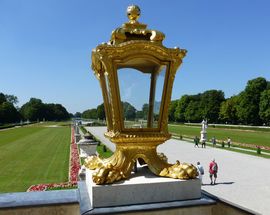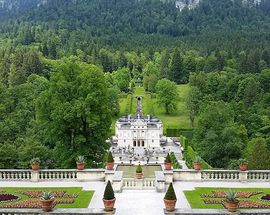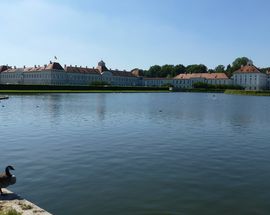Nymphenburg Palace
As you enter the Great Hall, the lavish Rococo decoration creates a jarring contrast with the elegant simplicity of the outer architecture. Colourful frescoes depict lively mythological scenes focusing on Flora, the goddess of spring and her Nymphs, after whom the palace was named. The hall was used for entertainment, and concerts are still hosted there today. This decadent artistic style may have rubbed off on the king, Ludwig I, who had a passion for young women. He had 36 portraits commissioned of the most beautiful ladies of the day and they were set up in a special gallery in the southern wing and named the Hall of Beauties. You can imagine the king wandering around in the room humming the tune ‘to all the girls I loved before.’ One of the beauties, Lola Montez, is depicted with a belt of snakes and a whip in her hand. (Apparently the king’s dalliance with this dominatrix dancer brought about the revolution in 1848.)
Another famous Bavarian king, Ludwig II or the ‘fairytale king,’ also left his mark on this palace, albeit unwillingly. Being primarily a country boy, he shunned Munich and its elitist upper class and preferred to build his own castles in the mountains (see Crazy castles) where he got up to all sorts of crazy pursuits. The results of some of them can be seen in the Royal Stables Museum (Marstallmuseum), which displays the extravagant Cinderella carriage, commissioned for the king’s wedding to duchess Sophie (which never took place). After he called their marriage off Ludwig took the golden carriage, decked out with tinkling bells and the first electric lights used in Germany and went on joy rides in the country in the wee hours of the morning. He also had matching sleighs he would ride in winter.
Above the Marstallmuseum is the Porcelain Museum, which displays some of the finest pieces of the world, mostly from the 18th century by the famous creator, Bustelli. The 200-hectare park surrounding the palace is an attraction of its own with the canal and reflecting pool before the entrance which runs to a cascade at the far end of the gardens. This a popular recreation spot in Munich and it is quite relaxing to have a picnic by the water with the swans and ducks, and there are many hidden treasures within the park.
On the south side is the Amalienburg, which was intended as a hunting lodge, but is decorated in a gaudy rococo style with bright colours and wall paintings, a hall of mirrors and silver ornaments. Behind this, near the great lake is the Badenburg Pavilion, the home of Europe’s first indoor heated swimming pool. The pool is decked in luxurious blue and white tiles and the ceilings overhead depict mythological bathing scenes. The Pagodenburg (currently closed for restoration) on the small lake on the northern side is a small Chinese pagoda decorated inside with pseudo-Chinese motifs. The Magdalenenklause, also on the northern side is a simple hermitage, intended as a retreat for prayer and solitude. Its rough and ready style and lack of ornaments is a breath of fresh air after all of the rococo of the previous buildings.
The Nymphenberg Palace is also home to the Botanical Garden with its geometrically landscaped area boasting over 15,000 different plants, plus lakes, canals, and cascades making it a magical day trip. There is also the Museum for Man and Nature, which caters mostly for kids and is open 09:00 to 18:00.
Open
Open 10:00-16:00.





Comments